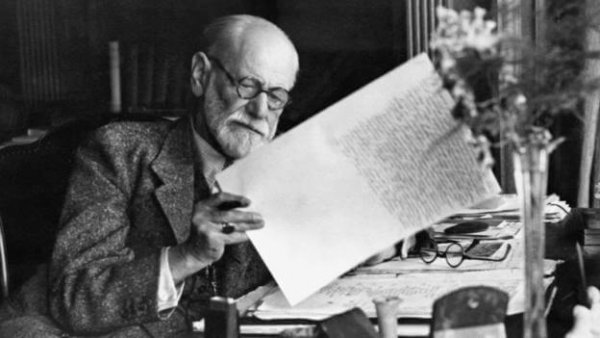What Exactly is Free Association?

Free association is a psychoanalysis tool created by the father of psychoanalysis himself, Sigmund Freud. It involves letting a patient express anything that comes to their mind during a session. The point is to do away with filters or judgment on what they think and share with the therapist.
Free association has a theoretical basis, a specific way to do it, and specific goals. It’s a fundamental part of psychoanalysis, but people also use it as a technique for certain projective tests, like the Rorscach test and the thematic apperception test (TAT).
The history of free association
Sigmund Freud developed the concept over a period of 6 years, between 1892 and 1898. Bit by bit, he took the hypnosis and catharsis methods he used at the beginning and replaced them with free association. His goal: to avoid suggestion.
Freud started to toy with the idea of free association after treating his patient Mrs. Emmy Von N. in 1892. She explicitly asked Freud to stop interrupting her train of thought. She wanted him to let her talk freely.

In 1904, in “The Psychoanalytic Method”, he then talked about why exactly he decided to drop hypnosis. After his work with Breuer, Freud realized that hypnosis only had partial, temporary results.
The free association method, though, could overcome a patient’s resistance. Therefore it would be much easier to access things from their unconscious mind (memories, weak spots, symbols). The effects of free association were also permanent. Plus patients didn’t have to undergo hypnosis for this technique.*
These are the reasons he replaced the hypnotic and cathartic methods with free association. Then he made it the basic principle of how to access and dig into the unconscious mind.
The theoretical basis of free association
When we talk, we choose the specific words we want to use to give coherency to the message we’re trying to send. We all use this word choice process, some people more quickly than others. But there are always mistakes: slips of the tongue, forgetting a word, repeating yourself, etc. We usually ignore these “mistakes” outside of a therapeutic setting. But inside, they’re extremely important.
“The unconscious is structured like a language.”
-Jaques Lacan-
Psychoanalysts see these “mistakes” as a manifestation of your unconscious. It’s almost like what you’re talking about has broken through your defensive barriers. The same kind of thing happens with free association.
Here, therapists free patients from their own self-control and help them forget their need to make their ideas logical. It’s the perfect environment to let themselves get carried away and their unconscious get stronger and speak. They open up, and that’s when you can access their unconscious.
“The voice of the intellect is a soft one, but it does not rest until it has gained a hearing.”
-Sigmund Freud-
Freud thought that exposing people’s resistances and then analyzing them was a fundamental part of healing. He also thought the only way to do that was through free association.
There are really three basic techniques for clinical analysis: free association, dream interpretation, and parapraxis. Free association is the most important one here, though. Freud saw it as the technique that really separated psychoanalytic therapy from all other kinds of therapy.

How exactly do you do free association?
Free association sometimes just happens on its own. Other times it happens through a dream, fantasy, or any other kind of thought. But for true free association, the patient has to trust their psychoanalyst.
They have to understand that a discussion with their analyst isn’t like a normal conversation. It’s not the same as talking to a friend or acquaintance in their daily life. There will be absolutely no judgment in the session. Nothing is right or wrong. Basically, everything they say goes.
The important part is when the patient lets their thoughts carry them away. Then they can openly express them to their analyst. What they’re doing here is letting unconscious symbols pop up to be analyzed, interpreted, and worked through. Once they’ve opened up their unconscious mind, they’ll be able to work through it consciously. The whole point of this is to keep something from being a source of discomfort or conflict.
“Unexpressed emotions will never die. They are buried alive and will come forth later in uglier ways.”
-Sigmund Freud-
How to encourage proper free association
Of course, free association will happen much more easily if the patient feels comfortable. Comfort has to do with both the analyst and the analytical space. There should be as little stimulation as possible in the analytical environment.
Before, a sofa was used. The patient would lie down and the analyst would be outside their field of vision, so they wouldn’t feel watched, judged, or evaluated. The idea was to help them focus completely on their associations.
The analyst would make a simple statement to the patient, “talk about anything,” or “say anything that comes to mind, any image or memory that you think of.” From there, the patient would be completely free to express whatever came into their head. They wouldn’t have to worry about being coherent or pleasing their analyst.
Footnote
*An analyst could access a patient’s unconscious mind with hypnosis; that wasn’t the problem. It was that most of the time patients would leave the hypnotic state and not remember what they said. Therefore their resistances would always come back into play. It ended up being the analyst’s word against the patient’s, and that really slowed things down.
On the other hand, patients are fully conscious with free association. That means they have to take responsibility for what they said when the analyst would try to explore it.
Free association is a psychoanalysis tool created by the father of psychoanalysis himself, Sigmund Freud. It involves letting a patient express anything that comes to their mind during a session. The point is to do away with filters or judgment on what they think and share with the therapist.
Free association has a theoretical basis, a specific way to do it, and specific goals. It’s a fundamental part of psychoanalysis, but people also use it as a technique for certain projective tests, like the Rorscach test and the thematic apperception test (TAT).
The history of free association
Sigmund Freud developed the concept over a period of 6 years, between 1892 and 1898. Bit by bit, he took the hypnosis and catharsis methods he used at the beginning and replaced them with free association. His goal: to avoid suggestion.
Freud started to toy with the idea of free association after treating his patient Mrs. Emmy Von N. in 1892. She explicitly asked Freud to stop interrupting her train of thought. She wanted him to let her talk freely.

In 1904, in “The Psychoanalytic Method”, he then talked about why exactly he decided to drop hypnosis. After his work with Breuer, Freud realized that hypnosis only had partial, temporary results.
The free association method, though, could overcome a patient’s resistance. Therefore it would be much easier to access things from their unconscious mind (memories, weak spots, symbols). The effects of free association were also permanent. Plus patients didn’t have to undergo hypnosis for this technique.*
These are the reasons he replaced the hypnotic and cathartic methods with free association. Then he made it the basic principle of how to access and dig into the unconscious mind.
The theoretical basis of free association
When we talk, we choose the specific words we want to use to give coherency to the message we’re trying to send. We all use this word choice process, some people more quickly than others. But there are always mistakes: slips of the tongue, forgetting a word, repeating yourself, etc. We usually ignore these “mistakes” outside of a therapeutic setting. But inside, they’re extremely important.
“The unconscious is structured like a language.”
-Jaques Lacan-
Psychoanalysts see these “mistakes” as a manifestation of your unconscious. It’s almost like what you’re talking about has broken through your defensive barriers. The same kind of thing happens with free association.
Here, therapists free patients from their own self-control and help them forget their need to make their ideas logical. It’s the perfect environment to let themselves get carried away and their unconscious get stronger and speak. They open up, and that’s when you can access their unconscious.
“The voice of the intellect is a soft one, but it does not rest until it has gained a hearing.”
-Sigmund Freud-
Freud thought that exposing people’s resistances and then analyzing them was a fundamental part of healing. He also thought the only way to do that was through free association.
There are really three basic techniques for clinical analysis: free association, dream interpretation, and parapraxis. Free association is the most important one here, though. Freud saw it as the technique that really separated psychoanalytic therapy from all other kinds of therapy.

How exactly do you do free association?
Free association sometimes just happens on its own. Other times it happens through a dream, fantasy, or any other kind of thought. But for true free association, the patient has to trust their psychoanalyst.
They have to understand that a discussion with their analyst isn’t like a normal conversation. It’s not the same as talking to a friend or acquaintance in their daily life. There will be absolutely no judgment in the session. Nothing is right or wrong. Basically, everything they say goes.
The important part is when the patient lets their thoughts carry them away. Then they can openly express them to their analyst. What they’re doing here is letting unconscious symbols pop up to be analyzed, interpreted, and worked through. Once they’ve opened up their unconscious mind, they’ll be able to work through it consciously. The whole point of this is to keep something from being a source of discomfort or conflict.
“Unexpressed emotions will never die. They are buried alive and will come forth later in uglier ways.”
-Sigmund Freud-
How to encourage proper free association
Of course, free association will happen much more easily if the patient feels comfortable. Comfort has to do with both the analyst and the analytical space. There should be as little stimulation as possible in the analytical environment.
Before, a sofa was used. The patient would lie down and the analyst would be outside their field of vision, so they wouldn’t feel watched, judged, or evaluated. The idea was to help them focus completely on their associations.
The analyst would make a simple statement to the patient, “talk about anything,” or “say anything that comes to mind, any image or memory that you think of.” From there, the patient would be completely free to express whatever came into their head. They wouldn’t have to worry about being coherent or pleasing their analyst.
Footnote
*An analyst could access a patient’s unconscious mind with hypnosis; that wasn’t the problem. It was that most of the time patients would leave the hypnotic state and not remember what they said. Therefore their resistances would always come back into play. It ended up being the analyst’s word against the patient’s, and that really slowed things down.
On the other hand, patients are fully conscious with free association. That means they have to take responsibility for what they said when the analyst would try to explore it.
This text is provided for informational purposes only and does not replace consultation with a professional. If in doubt, consult your specialist.







